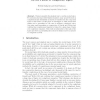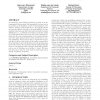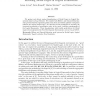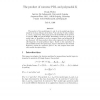130
click to vote
LICS
2012
IEEE
12 years 5 months ago
2012
IEEE
—A novel countermodel-producing decision procedure that applies to several multi-modal logics, both intuitionistic and classical, is presented. Based on backwards search in label...
CALCO
2011
Springer
13 years 3 months ago
2011
Springer
Fusion is arguably the simplest way to combine modal logics. For normal modal logics with Kripke semantics, many properties such as completeness and decidability are known to trans...
ATAL
2011
Springer
13 years 3 months ago
2011
Springer
In modal logic, when adding a syntactic property to an axiomatisation, this property will semantically become true in all models, in all situations, under all circumstances. For i...
CORR
2011
Springer
13 years 7 months ago
2011
Springer
We propose a new definition of the representation theorem for many-valued logics, with modal operators as well, and define the stronger relationship between algebraic models of ...
IGPL
2010
14 years 2 months ago
2010
Fusion is a well-known form of combining normal modal logics endowed with a Hilbert calculi and a Kripke semantics. Herein, fusion is studied over logic systems using sequent calc...
SLOGICA
1998
14 years 3 months ago
1998
We present and discuss various formalizations of Modal Logics in Logical Frameworks based on Type Theories. We consider both Hilbert- and Natural Deductionstyle proof systems for ...
NDJFL
2002
14 years 3 months ago
2002
Shortest possible axiomatizations for the implicational fragments of the modal logics S4 and S5 are reported. Among these axiomatizations is included a shortest single axiom for im...
MLQ
2000
14 years 3 months ago
2000
: Each information system (or data table) leads to a hierarchy of binary relations on the object set in a natural way; these relational systems can serve as frames for the semantic...
LOGCOM
2000
14 years 3 months ago
2000
The product of two modal logics L1 and L2 is the modal logic determined by the class of frames of the form FG such that F and G validate L1 and L2, respectively. This paper proves...
FUIN
2000
14 years 3 months ago
2000
We give algorithms to construct the least L-model for a given positive modal logic program P, where L can be one of the modal logics KD, T, KDB, B, KD4, S4, KD5, KD45, and S5. If L...




